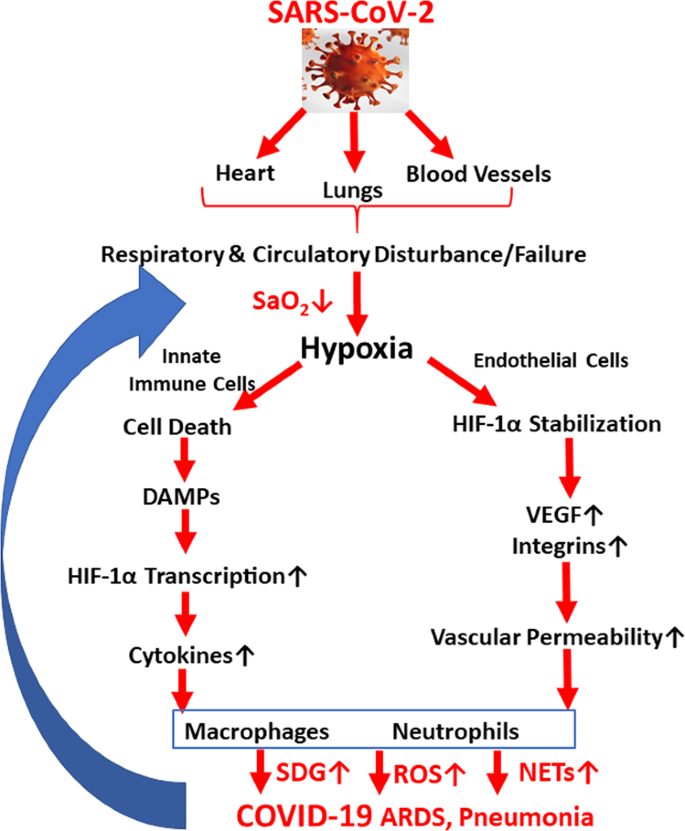However in happy hypoxia the person shows no such symptoms. Clinicians call them happy hypoxics.

Non Invasive Respiratory Support In The Treatment Of Acute Hypoxemic Respiratory Failure Secondary To Covid 19 Related Pneumonia European Journal Of Internal Medicine
The guidelines for the diagnosis treatment and control of the coronavirus disease 2019 COVID-19.

How to treat covid hypoxia. Check your oxygen levels with the help of a good pulse oximeter. Hypoxemia or hypoxia is a medical emergency and should be treated promptly. Around 80 of people with COVID-19 will have only mild disease.
Sciences COVID-19 coverage is supported by the Pulitzer Center. The target range SaO 2 for a normal. If doctors recognize silent hypoxia early enough it can be treated with oxygen therapy through nasal tubes a face mask or a tube placed in the windpipe.
Are COVID-19 patients that are suffering from hypoxia more at risk and do they require specific treatment. Oxygen therapy strategies and techniques to treat hypoxia in COVID-19 patients. Sign of Severity or Cause for Poor Outcomes I n December 2019 reports of an outbreak of an unusual viral pneumonia were released from Wuhan China which was later found to be due to infection with novel severe acute respiratory syndrome corona-virus 2.
The essence of oxygen therapy is to provide oxygen according to target saturation rate and to monitor the saturation rate to keep it within target range. Failure to initiate oxygen therapy can result in serious harm to the patient. All three experts agreed that there are no characteristics or criteria that determine whether a person is at higher risk of silent hypoxia.
The best way to prevent hypoxia is to keep your asthma under control every day. Cioe-Pena added that the worst time for hypoxia silent or not in coronavirus patients is around day 10 of the infection. Sciences COVID-19 coverage is supported by the Pulitzer Center.
Blood oxygen levels below 90 percent are considered to be too low and oxygen therapy is needed for such patients. We conducted a meta-analysis of the literature to assess the intubation rate among patients with COVID-19 requiring oxygen or noninvasive ventilatory support who. Silent hypoxemia or happy hypoxia is an unusual Covid-19 complication that has most baffled the scientific and medical community.
Gen therapy in COVID-19 patients to maximize oxygen therapy benefits minimize the risks and hopefully reduce mortality in COVID-19 pa-tients. A person with low oxygen levels would have symptoms like shortness of breath and chest pain. These findings shed light on the biological mechanisms underpinning the condition Gonzalez-Brito says potentially resolvingor at least taking a step toward resolvingone of COVID-19s many mysteries.
COVID- 9 The mystery of the pandemics happy hypoxia Doctors debate how to treat patients with low blood oxygen but without trouble breathing A pulse oximeter on a COVID-19 patients finger measures blood oxygenation. Infected patients with extraordinarily low blood-oxygen levels or hypoxia scrolling on their phones chatting with doctors and generally describing themselves as comfortable. Oxygen Nasal Cannula and Face Mask Nasal oxygen cannula is the most commonly used initial step for oxygen therapy in patients with mild hypoxia due to its simplicity reduced cost and ease of use.
By themselves none of these factors were enough to cause blood oxygen to drop to the levels recorded in COVID-19 patients and induce happy hypoxia. It is the need of the hour for COVID-19 patients to monitor their oxygen saturation levels at least twice a day to ensure they do not get into happy hypoxia. COVID-19 is primarily a respiratory illness and a severe case can reduce the amount of oxygen that the lungs can absorb.
When the lining of blood vessels get inflamed from COVID-19 infection tiny blood clots too small to be seen on medical scans can form inside the lungs. If your oxygen levels are less than 90 then you will have to seek a medical experts help and undergo appropriate treatment. Published by AAAS on June 21 2021.
Blood oxygen levels have been found to be very low in some COVID. Among the many surprises of the new coronavirus is one that seems to defy basic biology. Awake prone positioning PP or proning is used to avoid intubations in hypoxic patients with COVID-19 but because of the diseases novelty and constant evolution of treatment strategies the efficacy of awake PP is unclear.
Taken together however they were. Stick with your asthma treatment plan. Hypoxia is one of the primary causes that leads to multiple organ injuries and death in COVID-19 patients.
In the following months this viral infection known as coronavirus. Aggressive oxygen therapy for the treatment of hypoxia is important in saving these patients. They found using computer modeling of the lungs that this could incite silent hypoxia but alone it is likely not enough to cause oxygen levels to drop as low as the levels seen in patient data.

Hypoxia Hif 1a And Covid 19 From Pathogenic Factors To Potential Therapeutic Targets Acta Pharmacologica Sinica

Pdf The Pathophysiology Of Happy Hypoxemia In Covid 19

Pdf The Pathophysiology Of Happy Hypoxemia In Covid 19

Covid 19 Blood Vessel Damage May Cause Brain Fog And Other Long Hauler Symptoms Daic

Neurologic Complications Of Covid 19 The American Journal Of Emergency Medicine

Covid 19 What Is Happy Hypoxia Coronavirus Outbreak News

Covid Management Update Core Im Podcast

In Line Treatments And Clinical Initiatives To Fight Against Covid 19 Outbreak Respiratory Medicine

Covid 19 Clinical Management Guidelines Cayuga Medical Center
0 comments:
Post a Comment